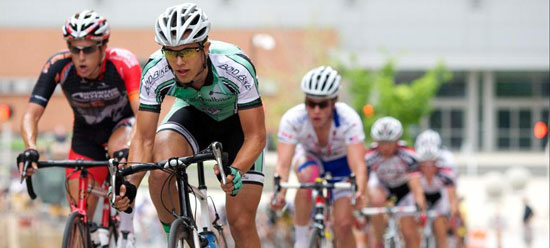On a twisting, winding, downhill road, 50 miles per hour in a car would probably feel like a steerable roller coaster. The same road at 50 miles per hour on a bicycle would probably feel more like an out of control nightmare. For cyclists, speeds of even 70 mph and up are part of the job with only their helmet, bike, and superior instincts to buffer against the unforgiving combination of gravity and asphalt. Even world class cyclists can fall victim to any combination of bad luck, mechanical failure, and a momentary (read split-second) lapse in judgment.

By all accounts, Wouter Weylandt was a world class cyclist. He was 26 and entering the prime of his racing career. (Lance Armstrong won 7 consecutive Tour de France titles starting at age 27.) He had raced for Quick Step, a premier cycling team competing in the biggest competitions in the world, before recently signing with upstart competitor Leopard Trek. His biggest professional accomplishment came during stage 3 of the 2010 Giro D’Italia, second only to the Tour de France in terms of importance in world cycling. The flat Dutch course fit his sprinting style perfectly, and he finished in front of a breakout group winning the stage.
364 days later, Wouter Weylandt was again riding in stage 3 of the Giro. 2011’s course led the riders through a mostly flat 107 mile section of the Italian countryside, with two sharp climbs toward the stage’s end. With about 10.5 miles to go, Weylandt was descending at a speed of 40-50 mph when, according to another rider, he turned his head to glance back up the hill. When he did so, the left side of his bike struck a low concrete guard rail and he was thrown across the road, impacting the pavement and another object over 30 feet away. The medical chief of staff for the race happened to be trailing Weylandt at that moment and was by his side less than 20 seconds after the crash. In his determination, the 26 year old Weylandt died immediately upon impacting the ground. In a split second, Wouter Weylandt had gone from a promising young cyclist in the prime of his career to a tragic example of the high-wire act athletes perform on a daily basis. The most heartbreaking aspect of Weylandt’s death had nothing to do with his cycling career: his girlfriend, Sophie, is carrying their first child and is due in September.
People watch sports for a number of reasons, but for most it’s a way to be in on the action. Fans watch because a part of them wishes they could be on the field – there’s not many football games I watch where I don’t at least momentarily think “Man, if I were 6’4″ and 250 pounds, I would’ve tackled that guy in a heartbeat.” People watch baseball, hockey, soccer, and cycling partially to have some psychological equity in the game. For most of us, watching the games on TV and cheering on our favorite athletes is the closest we’ll ever get to winning a yellow jersey or throwing a game-winning touchdown. No matter what happens on the field, when the TV goes off our lives carry on. The physical well-being of our favorite players seems almost abstract, as if the athletes themselves exist within the boundaries of the television set.
For athletes’ families, their physical well-being is a very real concept. Once the TV is turned off and the race or game is over, the families pick up where coaches and teammates leave off. Early morning training, meal preparation, and consistent emotional support all fall to families of professional athletes. When fans cheer and watch as athletes put their bodies on the line, their families are often on pins and needles. Wouter Weylandt’s death serves as a reminder that even with all the safety precautions athletes take, accidents can still happen. For families of athletes in general and cyclists in particular, the tragic possibilities are very real and the dangers ever-present.

Lindsay Sweeting, whose husband Bobby is a professional cyclist, has seen the dangers firsthand. He’s been run off the road in training by motorists and cyclists alike. He’s had arrows both verbal (about his cycling gear) and physical (a Big Gulp thrown from a 45 mph car) slung at him during rides. “He’s crashed multiple times in the same races,” she told me. “He once spent the night in the UC Irvine medical center’s burn unit getting treatments that required having a psychologist there to help him handle the pain.” They weren’t married at the time, so Lindsay and Bobby’s sister spent the night calling area hospitals until they finally found him. “That’s the kind of fear that athletes’ families live with.”
Lindsay was hit especially hard by Weylandt’s death. Safety is something always lingering in the back of her mind during a race. “The knowledge that something terrible can happen is always there,” she said, “but it has to be compartmentalized, only to be taken out of its box if I don’t see him after the peloton’s completed a lap or he’s 45 minutes late coming home from a ride.” Yet she also realizes that for top-flight riders like her husband, danger is part and parcel of professional cycling. “The best of the best are at the top because they’ve had to be fearlessly persistent facing dangers head-on in order to hone their craft.”
There’s no denying that Wouter Weylandt was among the best of the best. His professional career started at age 21 and at 26, entering the prime of his career, he died on one of cycling’s biggest stages. For the huge hole left in his cycling team, the Giro D’Italia, and the sport overall, none will be as big as the one felt by his girlfriend Sophie. Sports fans can view athletes as existing in a vacuum, as if they’re video game characters playing out their sport on television just for us. But the constant fear of danger is real, and it’s people like Sophie and Lindsay Sweeting who carry the burden most directly. “You can only keep yourself so safe, as an athlete,” Lindsay told me. “There’s a point at which you (and your family) just have to start being prepared for the worst, too.”
Images of Bobby Sweeting courtesy of Bobby Sweeting.
Image of Wouter Weylandt courtesy of Alyson Lindley via Wikipedia, CC 3.0.
